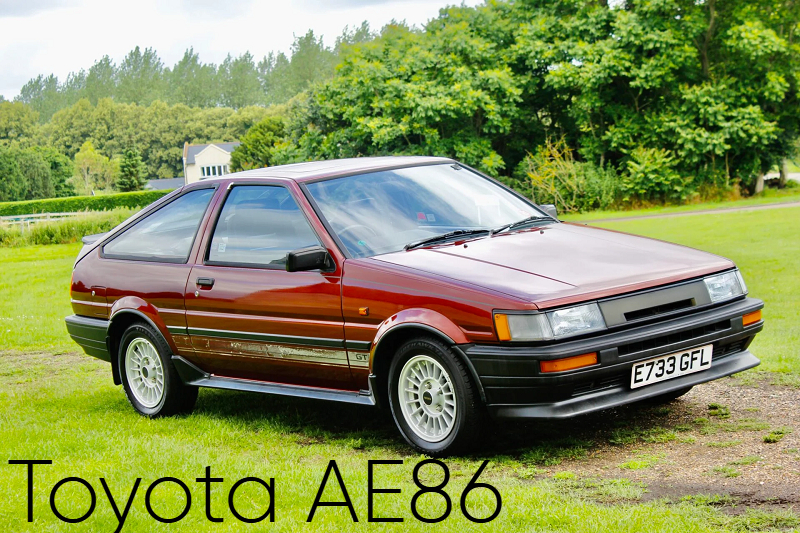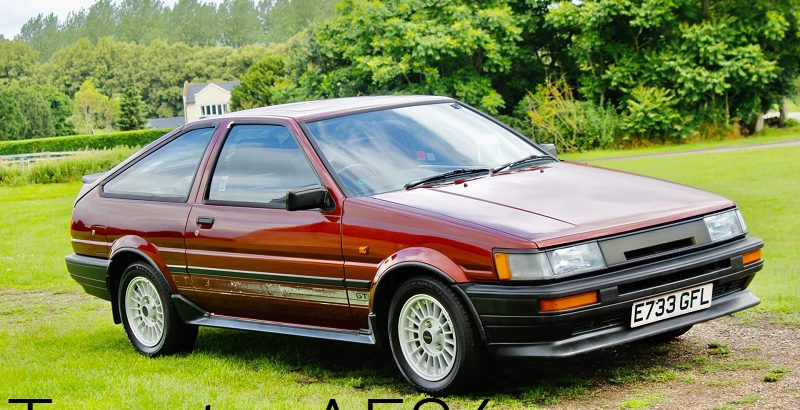
Introduction
The Toyota AE86, commonly referred to as the Hachiroku (meaning “eight-six” in Japanese), stands as one of the most legendary vehicles in Japanese Domestic Market (JDM) history. Manufactured between 1983 and 1987, this car belonged to the Toyota Corolla Levin and Sprinter Trueno lineup and developed a cult following among automotive enthusiasts, drifters, and motorsport fans globally.
This compact yet powerful vehicle gained recognition for its lightweight construction, rear-wheel-drive (RWD) layout, and responsive high-revving engine. Over the years, the AE86 has been celebrated for its raw driving experience, securing its status as an enduring automotive icon. Additionally, the car was cemented in popular culture through the Initial D anime and manga series, where it was depicted as the ultimate underdog machine that could outperform more powerful vehicles through sheer skill and balance.
Historical Development and Toyota’s Vision for the AE86
Toyota introduced the AE86 as part of the fifth-generation Corolla (E80 series). At a time when front-wheel-drive (FWD) layouts were becoming the industry standard due to cost and efficiency, Toyota chose to retain the RWD configuration for the AE86. This decision made the car highly appealing to performance drivers, allowing it to thrive in motorsports and grassroots racing.
The AE86 came in two primary variants:
- Toyota Corolla Levin AE86 – Designed with a fixed-headlight front end for a sportier, aggressive look.
- Toyota Sprinter Trueno AE86 – Distinguished by its signature pop-up headlights, which added to its appeal in the JDM tuning scene.
Both versions were offered in hatchback and coupe body styles, providing flexibility for buyers based on aesthetic preference and intended use. The AE86’s compact dimensions and lightweight frame—approximately 950-1,100 kg (2,100-2,400 lbs)—resulted in an exceptionally nimble driving experience, particularly in winding mountain roads and racing circuits.
Engine and Mechanical Performance
Under the hood, the AE86 housed the revered 4A-GE engine, a 1.6-liter inline-4 DOHC (Dual Overhead Camshaft) unit that played a significant role in Toyota’s engineering advancements during the 1980s. One of the earliest mass-produced engines to feature electronic fuel injection (EFI), the 4A-GE delivered a power output ranging from 112 to 130 horsepower, depending on regional market variations and factory tuning.
Key Specifications of the 4A-GE Engine:
- Displacement: 1.6L Inline-4
- Configuration: Dual Overhead Camshaft (DOHC) with 16 Valves
- Fuel System: Electronic Fuel Injection (EFI)
- Maximum RPM: 7,600 RPM redline
- Power Output: 112-130 HP
- Torque: 131 Nm (97 lb-ft)
- Drive Layout: Rear-Wheel Drive (RWD)
- Transmission: 5-Speed Manual or 4-Speed Automatic
The AE86’s remarkable power-to-weight ratio combined with its Limited-Slip Differential (LSD) option allowed for precise cornering ability and effortless power delivery. These attributes made it a dream car for drifting, autocross, and amateur racing competitions.
Motorsports Dominance and Drifting Culture
The AE86 became synonymous with motorsports and grassroots racing, especially in the hands of Keiichi Tsuchiya, Japan’s renowned “Drift King.” Tsuchiya played a significant role in promoting drifting as an art form, often demonstrating the AE86’s capabilities on winding mountain roads and in professional racing circuits.
The AE86 in Competitive Racing:
- Japanese Touring Car Championship (JTCC)
- All-Japan Rally Championships
- D1 Grand Prix Drifting Competitions
- Club Racing, Autocross, and Gymkhana Events
Despite its relatively modest horsepower compared to modern sports cars, the AE86 excelled due to its balanced chassis, lightweight design, and exceptional handling characteristics. Even decades after its initial release, it remains a go-to choice for grassroots motorsport competitors and drift enthusiasts.
The AE86 in Popular Culture: The Initial D Effect
The global popularity of the AE86 was propelled by the success of Initial D, a manga and anime series created by Shuichi Shigeno. The story follows Takumi Fujiwara, a young delivery driver who unknowingly hones his drifting skills while delivering tofu in his father’s Toyota Sprinter Trueno AE86.
Initial D portrayed the AE86 as an underdog hero, competing against much more powerful sports cars while emphasizing driver skill, vehicle control, and mechanical tuning. The series introduced a new generation of enthusiasts to the JDM culture, drifting, and mountain racing, making the AE86 a highly sought-after collector’s item.
Why the Toyota AE86 Remains an Enthusiast’s Dream
- Lightweight, Agile, and Engaging Driving Dynamics – The AE86’s chassis design and RWD layout ensure exceptional handling and responsiveness.
- High Tuning Potential – The 4A-GE engine is highly adaptable, allowing for turbocharging, supercharging, and full engine swaps.
- Timeless JDM Appeal – The AE86 holds its value as one of the most recognizable JDM classics.
- Drifting Icon – A perfect 50/50 weight distribution, LSD option, and nimble steering make it ideal for drifting enthusiasts.
- Reliability and Longevity – Toyota’s robust engineering means that properly maintained AE86s can run for hundreds of thousands of miles.
- Cultural and Historical Significance – From Initial D to its real-world motorsport legacy, the AE86 continues to inspire enthusiasts worldwide.
AE86 Modifications and Customization Trends
Many owners choose to modify their AE86s to enhance performance, aesthetics, and drivability. Some of the most popular upgrades include:
- Engine Swaps: 4A-GZE (Supercharged), 20V 4A-GE, SR20DET, 2JZ-GTE, or K20 swaps
- Suspension Upgrades: Coilovers, strut tower braces, upgraded sway bars
- Brake Enhancements: Aftermarket disc brakes, performance pads, and big brake kits
- LSD (Limited-Slip Differential): Essential for drifting and competitive driving
- Aesthetic Modifications: TRD body kits, over-fenders, custom decals, and aftermarket wheels
- Interior Enhancements: Racing bucket seats, Nardi steering wheels, and digital gauge clusters

Market Trends and Rising Collector Value
Due to its legendary status and limited supply, AE86 prices have surged in the collector’s market. While these cars were once affordable, pristine and modified examples now command prices ranging from $20,000 to over $50,000, with special editions such as the Black Limited fetching even higher values.
Conclusion: The AE86’s Timeless Legacy
The Toyota AE86 remains one of the most beloved and celebrated vehicles in automotive history. With its driver-focused experience, tuning potential, and cultural significance, the AE86 continues to influence modern car culture. Whether as a drift legend, motorsport competitor, or collector’s item, the AE86’s impact is undeniable.
For those lucky enough to own one, the AE86 represents more than just a car—it’s an embodiment of JDM heritage, driving passion, and mechanical purity. The AE86 may have been discontinued, but its legacy lives on in the Toyota 86, Subaru BRZ, and GR86, all of which pay homage to this automotive legend.
